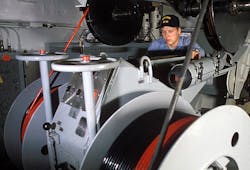Boeing Argon ST to provide Navy with five torpedo-spoofing decoys to protect surface warships
Officials of the Naval Sea Systems Command in Washington announced a $6.5 million contract modification Monday to Argon ST, a wholly owned subsidiary of the Boeing Co., to provide five AN/SLQ-25A/C countermeasure decoy systems.
The contract modification, which includes spare parts, is to provide improved naval surface ship defense against modern advanced torpedoes in support of the Navy's Undersea Defensive Warfare Programs.
Related: Boeing to provide torpedo defense systems to Navy
The AN/SLQ-25A/C is a digitally controlled modular electro-acoustic softkill countermeasure decoy system that employs an underwater towed body acoustic projector deployed from the ship's stern on a fiber optic tow cable to defend ships against wake-homing, acoustic homing, and wire-guided enemy torpedoes.
Since 2006, Argon has served as the lead contractor for the torpedo countermeasures transmitting set AN/SLQ-25 -- commonly referred to as Nixie. It is a passive decoy system that provides deceptive countermeasures against acoustic homing torpedoes.
The AN/SLQ-25 is deployed on U.S. and allied surface warships, and consists of the TB-14A towed decoy device and a shipboard signal generator. The decoy emits signals to draw incoming torpedoes away from their intended targets.
Related: Navy researchers survey industry for underwater acoustic projector for LCS torpedo defense
The AN/SLQ-25 towed decoy emits simulated ship noise like the sounds of propellers and engines in attempts to defeat a torpedo's passive sonar.
The AN/SLQ-25A uses a fiber optic tow cable and winch, and includes extensive use of commercial off-the-shelf (COTS) components. The AN/SLQ-25C is an upgrade to the AN/SLQ-25A, and includes new countermeasure modes and a longer tow cable.
On this contract modification Argon ST will do the work in Smithfield, Pa., and should be finished by September 2016. For more information contact Argon ST online at www.argonst.com, or Naval Sea Systems Command at www.navsea.navy.mil.
